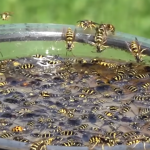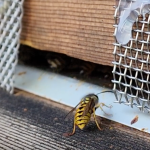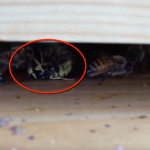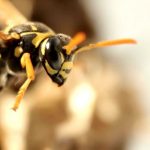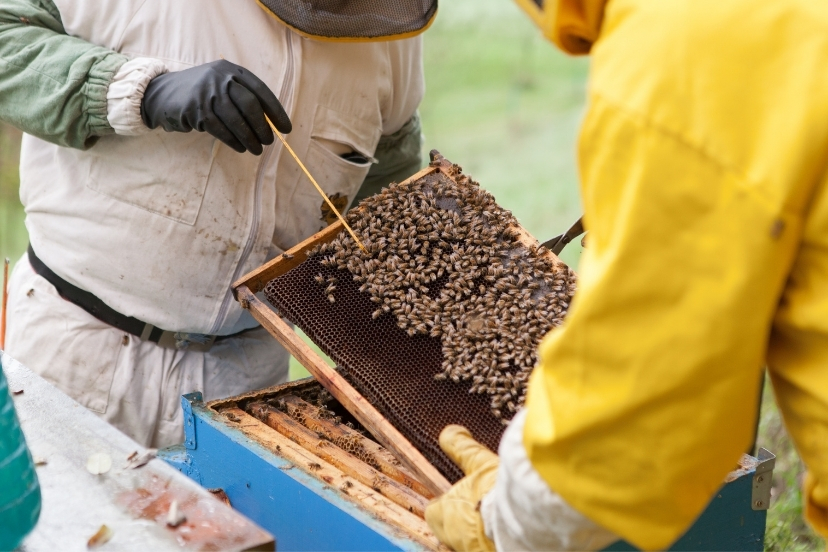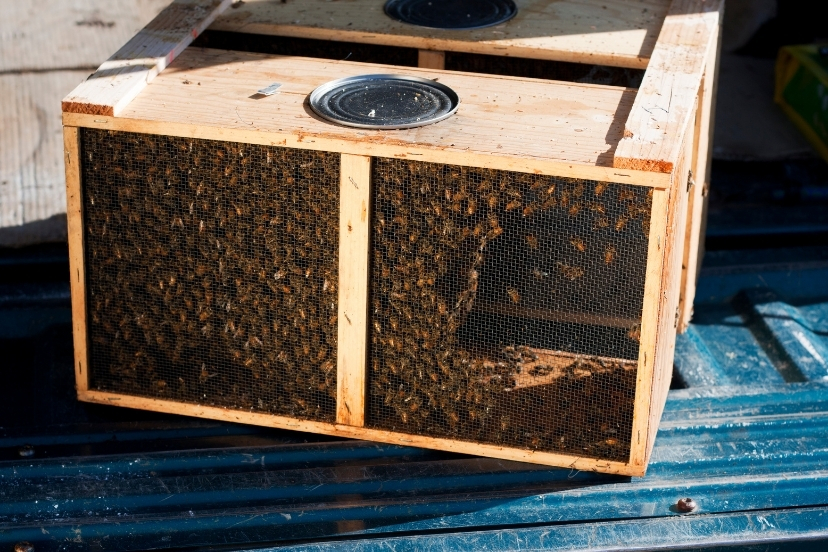As a beekeeper for over 15 years, I’ve discovered that wasps near beehives present one of our most fascinating yet challenging relationships in the apiary. Having dealt with numerous wasp incidents over the years, I’ve developed an in-depth understanding of their behavior that I’m excited to share.
For a complete defensive strategy, explore my 10 Effective Strategies for Preventing Wasps in Beehives post which pairs perfectly with the seasonal knowledge in this guide.
Understanding Wasps and Beehives
The relationship between wasps and beehives is more complex than most realize. Through my years working with bees, I’ve identified several species that frequently interact with our hives: Vespula vulgaris (common wasp), Vespula germanica (German wasp), Vespa crabro (European hornet), and Dolichovespula media (median wasp).
These social wasps operate in colonies remarkably similar to our honeybees, but with fascinating differences. A typical colony starts with a single queen and can grow to house 4,000-6,000 workers by late summer. The largest recorded wasp nest in my area spanned nearly four feet in diameter!
What draws wasps to our hives? It’s a combination of factors that I’ve observed over the years:
- Protein-rich bee larvae and pupae (their preferred food source)
- Stored honey and nectar (especially important in late summer)
- Dead or weakened bees (easy protein sources)
- General hive activity and movement (attracts hunting wasps)
- Pheromones from the colony (can attract wasps from considerable distances)
- Water sources near hives (particularly important during dry spells)
The physical structure of wasps is perfectly adapted for their predatory lifestyle. Their slender “waist” allows for incredible maneuverability, while their powerful mandibles can easily overpower smaller insects. I’ve watched in amazement (and horror) as a single wasp can dissect a honeybee with surgical precision in under a minute.
Seasonal Patterns in Wasp Activity
Understanding the yearly cycle of wasp behavior has been crucial to my success as a beekeeper. Like clockwork, these patterns shift with the changing seasons, each bringing its own unique challenges and opportunities for hive protection.
Through careful observation over many seasons, I’ve noticed that wasp activity near beehives follows predictable patterns that we can use to our advantage. Let me share what I’ve learned about these seasonal changes and how they affect our colonies.
Spring Emergence and Early Colony Development
Spring is when everything kicks into gear. Queens emerge from hibernation when temperatures consistently reach 50°F (10°C). I usually spot the first queens in early March, though this varies significantly by region and local climate conditions.
During this period, queens are surprisingly vulnerable. Only about 1% of queens successfully establish a colony. They’re frantically searching for nest sites while avoiding predators and dealing with unpredictable weather. I’ve noticed they’re particularly drawn to:
- Sheltered areas with overhead protection
- South-facing locations that receive morning sun
- Areas with easy access to water and building materials
- Protected spots near consistent food sources
The queen’s first task is building the initial nest structure. It’s fascinating to watch this process:
- She chews wood fiber to create a paper-like material
- Builds a sturdy stalk called a petiole
- Constructs the first cells in a hexagonal pattern
- Lays eggs and begins foraging for food
The early nest is about the size of a golf ball with just 20-30 cells. Each cell will house a single developing wasp, carefully tended by the queen.
Early Summer Behavior (June-July)
Early summer marks the transition from a solo queen operation to a growing colony. The first worker wasps emerge about 30 days after egg-laying begins. This is when my preventive measures kick into high gear.
The colony’s growth during this period is exponential. Each week brings new workers, and their protein needs increase dramatically. During this phase, I’ve observed:
- Workers gradually taking over foraging duties from the queen
- Increased predation on smaller insects
- Initial exploration of nearby beehives
- Establishment of regular foraging patterns
- Development of territory marking behaviors
Interestingly, wasps are most active during specific times of day:
- Early morning (6-8 AM): Initial foraging begins
- Mid-morning (9-11 AM): Peak hunting activity
- Afternoon (2-4 PM): Second activity peak
- Evening (6-8 PM): Final foraging push
Late Summer Competition (August-September)
This is when things get intense. By August, wasp colonies reach peak strength, often housing thousands of workers. The protein demands of the colony skyrocket as they’re raising new queens and males.
I’ve learned the hard way that this is the most dangerous period for beehives. Wasps become notably more aggressive, and weak colonies can be decimated. In fact, I lost two nucs one August before developing better protection strategies.
During this period, wasps exhibit sophisticated hunting behaviors:
- Testing different areas of the hive for weaknesses
- Working in small groups to overwhelm guard bees
- Creating diversions at one entrance while others slip in elsewhere
- Targeting specific resources within the hive
- Remembering successful entry points and returning to them repeatedly
The growing scarcity of natural food sources drives wasps to become more persistent around beehives. They develop efficient raiding strategies, often working in coordinated groups to overwhelm hive defenses. I’ve seen groups of 8-10 wasps systematically attacking a single hive entrance.
Autumn Nesting and Foraging Behaviors
As autumn approaches, wasp behavior shifts dramatically. The colony’s focus turns to raising new queens while the workers become increasingly desperate for food. They’re particularly attracted to sweet sources now, which explains their persistence around fallen fruit and picnic areas.
Around beehives, autumn wasps show fascinating patterns:
- More frequent visits during early morning and late evening
- Increased scavenging behavior
- Greater interest in dead bees and hive debris
- More erratic flight patterns
- Heightened aggression due to food scarcity
- Changes in preferred food sources
Weather impacts become more pronounced during this season:
- Wasps become less active in cooler temperatures
- Rain significantly reduces foraging activity
- Windspeed above 15 mph limits flight capability
- Sudden temperature drops can cause temporary disorientation
Winter Survival Strategies
Winter brings dramatic changes to wasp colonies. Unlike honeybees, most of the colony doesn’t survive winter. Only newly mated queens enter hibernation, while workers and old queens perish.
The queens seek out sheltered spots for hibernation:
- Tree hollows and stumps
- Wall cavities and attic spaces
- Underground burrows
- Thick vegetation or leaf litter
- Rock crevices and stone walls
Survival rates during winter are surprisingly low:
- Only about 1% of queens survive to spring
- Temperature fluctuations can cause premature emergence
- Wet conditions often lead to fungal infections
- Predation during hibernation is common
Impact of Weather on Wasp Activity
Weather significantly influences wasp behavior around beehives. Through careful observation, I’ve documented:
Temperature Effects:
- Optimal activity occurs between 70-85°F (21-29°C)
- Activity decreases below 50°F (10°C)
- Wasps become sluggish above 95°F (35°C)
- Freezing temperatures are usually fatal to workers
Rainfall Impact:
- Light rain doesn’t deter determined wasps
- Heavy rain halts most activity
- Post-rain periods often see increased foraging
- High humidity can affect flight capability
Wind Effects:
- Light breezes (under 10 mph) have minimal impact
- Moderate winds (10-20 mph) reduce foraging range
- Strong winds (over 20 mph) significantly limit activity
- Gusting winds can disorient wasps in flight
Management Strategies for Beekeepers
Through years of trial and error, I’ve developed several effective management strategies:
Physical Barriers:
- Entrance reducers (installed before wasp season peaks)
- Wasp traps placed 10-15 feet from hives
- Screen barriers over ventilation holes
- Custom-designed entrance guards
- Robbing screens during peak pressure periods
Biological Controls:
- Maintaining strong colonies
- Regular hive inspections
- Strategic placement of decoy wasp nests
- Companion planting to attract wasps away from hives
- Natural predator encouragement
Chemical Controls (as a last resort):
- Natural deterrent sprays
- Professional-grade wasp treatments
- Pheromone traps
- Essential oil-based repellents
- Organic acid treatments
Current Research and Future Considerations
Recent research has revealed fascinating insights about wasp behavior and intelligence. Studies show they can:
- Recognize individual faces
- Remember food locations for several days
- Learn from their nestmates’ experiences
- Adapt hunting strategies based on prey behavior
- Communicate threat levels to their colony
Climate change is already affecting wasp behavior patterns:
- Earlier spring emergence
- Extended active seasons
- Changes in geographical distribution
- Altered prey availability
- Modified nesting patterns
The impact of these changes requires beekeepers to:
- Monitor local weather patterns closely
- Adjust management timing seasonally
- Install additional protective measures
- Maintain detailed observation records
- Share findings with other beekeepers
Through decades of observation and countless interactions with wasp colonies, I’ve learned that success in managing wasps near beehives comes from understanding their behavior patterns and responding accordingly. While they can be challenging neighbors, wasps play important roles in our ecosystems. The goal isn’t to eliminate them but to protect our hives while maintaining ecological balance.
Remember, every location and situation is unique. What works in one apiary might need adjustment in another. Success comes from careful observation, consistent monitoring, and adaptable management strategies. Stay vigilant, keep learning, and don’t hesitate to adjust your approach as conditions change.

